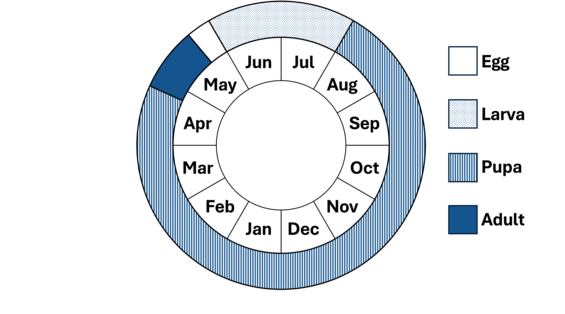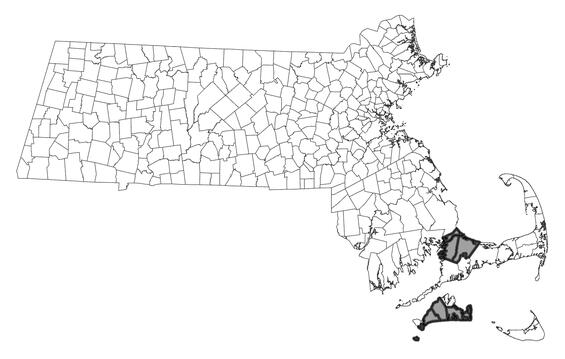- Scientific name: Lycia ypsilon
- Species of Greatest Conservation Need (MA State Wildlife Action Plan)
- Threatened (MA Endangered Species Act)
Description

Woolly gray (Lycia ypsilon)
The woolly gray (Lycia ypsilon) is a geometrid moth with a wingspan of 30-35 mm (1.2-1.5 in) in the male (Covell 1984); the wings of the female are nonfunctional, rudimentary buds. In the male, both the forewing and the hind wing are gray, with black, smoothly curved postmedial and antemedial lines. On the forewing, the median area is white, bisected by a black, relatively straight and wide median line. The postmedial line is margined by a brown band distally, and brown shading is present proximal to the antemedial line. There is a black apical dash on the forewing and a black anal dash on the hind wing. The reniform and discal spots are reduced to small, solid, black dots; the reniform spot may be obscured by the median line. White subterminal lines are present on the forewing and the hind wing but may be obscure on the hind wing. In both sexes, the thorax and abdomen are densely hairy, gray, or grayish tan in color, with black paired dots on the dorsum of each abdominal segment.
Life cycle and behavior

In Massachusetts, male woolly gray moths fly from late April through late May. Females ascend shrub and tree trunks and emit pheromone, waiting for males to find them by scent. The larval host plants are undocumented in Massachusetts; this species feeds on rose family plants (Rosaceae) elsewhere. Larvae are fully grown by late July (Forbes 1948). Pupae overwinter.
Distribution and abundance
The woolly gray is found from Massachusetts south to Florida, and west to Minnesota and Texas (Covell 1984). In Massachusetts, this species occurs on Martha’s Vineyard and inner Cape Cod.

Distribution in Massachusetts.
2000-2025
Based on records in the Natural Heritage Database.
Habitat
In Massachusetts, the woolly gray inhabits open, shrubby areas within pitch pine-scrub oak barrens.
Healthy habitats are vital for supporting native wildlife and plants. Explore habitats and learn about conservation and restoration in Massachusetts.

Open shrubby area within pitch pine-scrub oak barrens, habitat for the woolly gray. Habitat managed by DCR and TNC at Manuel F. Correllus State Forest.
Threats
The woolly gray is threatened by habitat loss and fire suppression in its disturbance-dependent habitat, in particular pitch pine-scrub oak barrens. Other potential threats include introduced generalist parasitoids, aerial insecticide spraying, non-target herbicide application, and off-road vehicles. The effect of a warming climate may not be detrimental to this species in Massachusetts; its range extends south to Florida, suggesting adaptation to warm temperatures.
Conservation
Land protection and habitat management are the primary conservation needs of this species in Massachusetts. In particular, coastal pitch pine-scrub oak barrens should be conserved, restored, and managed to maintain habitat for this species and the entire suite of rare and threatened species dependent on such habitat.
Survey and monitoring
The distribution of the woolly gray in coastal pitch pine-scrub oak barrens is well documented. Known populations of this species should be surveyed to document persistence at least once every 25 years; every 10 years is more desirable when practicable.
Management
Management of coastal pitch pine-scrub oak barrens benefits a suite of rare and threatened species, and habitat condition should be monitored and management adapted as needed. For the woolly gray, open, shrubby barrens are of particular importance.
Research needs
The natural history and conservation needs of the woolly gray are not well understood. In particular, the specific larval host plants used in Massachusetts are not known. As with other species with a geographic range mostly south of Massachusetts, the future effects of a warming climate on this species are unpredictable and should be documented.
References
Covell, C.V. 1984. A Field Guide to Moths of Eastern North America. Peterson Field Guide Series. Houghton Mifflin, Boston, Massachusetts. 496 pp.
Forbes, W.T.M. 1948. Lepidoptera of New York and Neighboring States. Part II. Memoir 274, Cornell University Agricultural Experiment Station, Ithaca, New York. 263 pp.
Contact
| Date published: | March 7, 2025 |
|---|